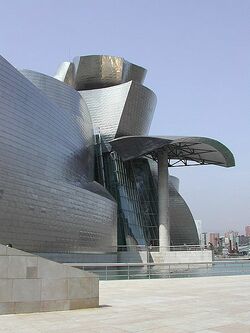Surface (geometry): Difference between revisions
Jump to navigation
Jump to search

imported>Miguel Adérito Trigueira (Euclidian definition for the plain man) |
imported>Thomas Wright Sulcer (added picture) |
||
| Line 1: | Line 1: | ||
{{subpages}} | {{subpages}} | ||
[[Image:Guggenheim bilbao02.jpg|thumb|250px|alt=Picture of the outside of a building.|The Guggenheim Museum in Balbao has eye-catching surfaces.]] | |||
A '''surface''' in mathematics has many different uses, the most common referring to a two-dimensional submanifold of three-dimensional Euclidean space, <math>\scriptstyle \mathbb{R}^2</math>. | A '''surface''' in mathematics has many different uses, the most common referring to a two-dimensional submanifold of three-dimensional Euclidean space, <math>\scriptstyle \mathbb{R}^2</math>. | ||
Revision as of 17:41, 17 March 2010
A surface in mathematics has many different uses, the most common referring to a two-dimensional submanifold of three-dimensional Euclidean space, .
Any set of points composed of pieces topologically equivalent to a subset of a plane is a surface: this includes curved surfaces such as a paraboloid, infinite surfaces such as a plane, surfaces of limited extent such as the interior of a polygon, and surfaces with strange topology such as an infinitely long row of squares each separated by some distance, or the set of all points with rational coordinates in a plane. The extremities of a solid are made up of surfaces.
A surface has length and breadth only. A surface that is flat is called a plane.

